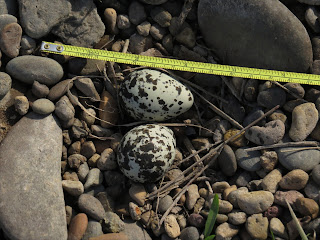Springs rolls on. While down along the river this morning, I heard my first House Wren of the year (a nesting bird), and found the Killdeer were already at it. As you can see, Killdeer don't go in for nest building -- just a simple scrape. But the eggs aren't actually that noticeable; one could step on them quite easily, and watching where you are walking is advisable. Luckily when Killdeer are in the area, you will likely know it due to their strident alarm calls, and hair-trigger sensitivity, occasionally feigning a broken wing to lure predators away from the nest, etc.
Their appearance is also distinctive. People that have essentially no knowledge of birds often recognize them when shown a photo: they just didn't know what they were called. So here's a photo. The Killdeer is the bird on the left. The bird on the right is a Greater Yellowlegs. This photo was taken April 3, but is likely one of the same birds involved with this nest. I'm using this image because it contains that Yellowlegs. That is a matter for another post, but this way I get to use the same image, and I'm lazy.
In addition to not stomping up a beach like a Marine going into combat, likely crushing eggs, there are a couple of other guidelines related to nests that you might want to be aware of. Simple things like how to minimize the disturbance you cause. All About Birds has already posted one, so I don't have to.
I specifically wanted to limit my time at this nest, on this day. I had already seen three species of corvid (Steller's Jay, Western Scrub Jay, and American Crow). Corvids are infamous nest-robbers. The tape measure is always with me in the field -- it's not like I had to go get it and return, causing two disturbances. My total time at the nest was 1:38 from first to last image according to Exif data, and laying down a tape obviously took only seconds. One other thing I did was place a couple of rocks to point to the site. My total time was still under 2 minutes.
With the rocks, I can find it again from a distance, and have no need to closely approach it. The normal clutch size is 4-6 errors, so these birds just started. Incubation period is 22-28 days. In a month or so, I should see tiny little fuzz-balls on the beach. They can walk away from the nest as soon as their feathers are dry, and they're fun to watch.


No comments:
Post a Comment